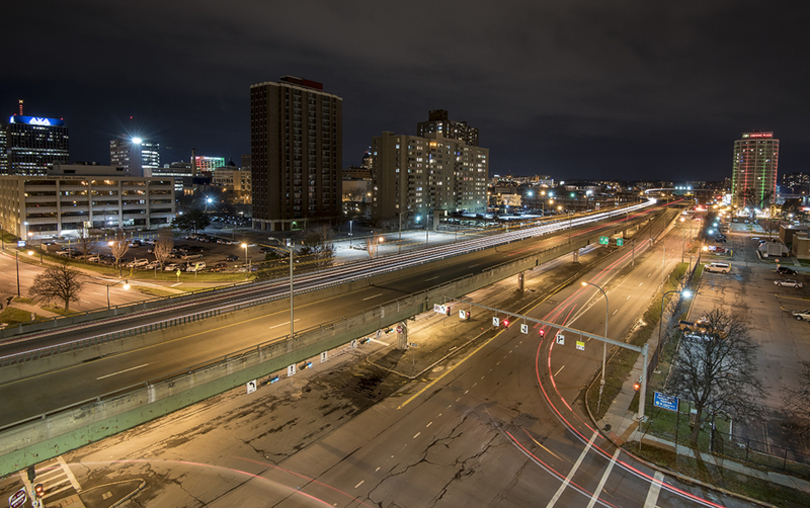Experts weigh in on the future of cities as Syracuse decides what to do with I-81

Interstate 81 will reach the end of its usable life in 2017 and experts have advice for the community as it decides its future. Wasim Ahmad | Staff Photographer
The future of Interstate 81 in Syracuse is currently up in the air, but experts say that change for the city is inevitable and a necessary solution.
After years of debate and discussion about the future of I-81, the highway will reach the end of its usable life this year and a decision for what will replace it is pending.
The state had originally narrowed the options for replacing I-81 down to two — the community grid and rebuild options — from 16 last year. But after pressure from New York state Sen. John DeFrancisco (R-50th), Gov. Andrew Cuomo (D) ordered the New York State Department of Transportation to have an independent consultant review all options — including the different tunnel options dismissed by the state — for replacing the major highway, according to Syracuse.com.
The NYSDOT did not respond to multiple requests for comment on this article.
WSP/Parsons Brinckerhoff is conducting the review, which isn’t expected to be finished until this summer.
The current options on the table include the community grid option, which would destroy the I-81 viaduct and replace it with a street level road, while rerouting interstate traffic east around the city on what’s currently Interstate 481. In contrast, with the rebuilding option, the viaduct would become taller and wider. With the tunnel option, traffic would be directed underneath Syracuse. The viaduct would also be destroyed with the tunnel option, and a street level road would take its place.
Cuomo is already pushing through a number of other large costly infrastructure projects. Examples include the Tappan Zee Bridge replacement project, the closure of the Indian Point nuclear plant and the completion of a statewide bike trail, said Ray Bromley, a professor in the State University of New York at Albany’s geography and planning department. Which is why, he added, he believes an I-81 tunnel underneath Syracuse won’t work out.
“Just my gut reaction is that tunneling in Syracuse goes beyond the financially feasible, given that it’s almost certainly going to have big cost overruns,” he said.
Bromley compared the I-81 tunnel option — which is the most costly option on the table for the project, estimated to cost $3.1 billion by the NYSDOT — to the Big Dig mega project in Boston, which went about $21.4 billion over budget, according to The Boston Globe.
“Using 481 as the choke route does make quite a lot of sense,” said Bromley, referring to the community grid’s proposed reroute of interstate traffic around the city.
Both Bromley and Rick Geddes, the director of Cornell University’s Program in Infrastructure Policy, also said the planned replacement of I-81 in Syracuse is part of a growing trend in the United States to remove large highways that, when built, bisected cities.
“It’s basically about reviving cities and tying neighborhoods back together again,” Bromley said, referring to the motivations behind the trend. Some residents in Syracuse, however, worry the I-81 replacement project may damage communities again.
Geddes added that people are beginning to rethink Robert Moses’ — an infamous city planner who worked in the New York City area during the early and mid-20th century — belief that putting an interstate through the middle of a city is a good idea.
In an attempt to raze similar 1950s and ‘60s-era interstate highways, New York state is looking to dismantle the Sheridan Expressway in the Bronx, for example.
Buffalo is also considering options for big changes to two major roadways. The Scajaquada Expressway and the Kensington Expressway effectively bisected two stable neighborhoods and pushed people out into the suburbs, said Robert Shibley, dean of the School of Architecture and Planning at the State University of New York at Buffalo.
Shibley, an expert in urban planning in the Rust Belt of which Syracuse is a part of, said he wants to see parts of these expressways altered, which would reconnect parts of the city. That could be a possibility for Syracuse, he said, adding that divisions about the best way to do this are common, though, because people often make decisions based on assumptions.
“The assumptions are sometimes self-fulfilling prophesies. If you assume the positive, you may well create it. If you assume the negative, you will definitely achieve it,” Shibley said.
Ultimately, he said, community members and state leaders have to decide where the best place is to put their money. As Bromley pointed out, the state is currently investing in many large infrastructure projects, which may limit how much funds are available for Syracuse.
“You’re throwing in a few billion here and a few billion there,” Bromley said. “There’s a lot of very ambitious projects out there right now.”




